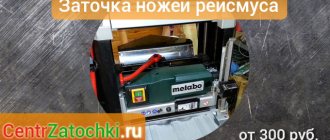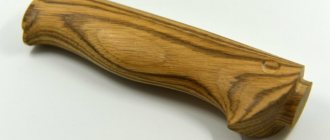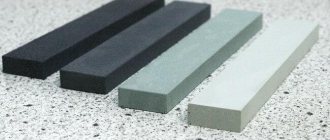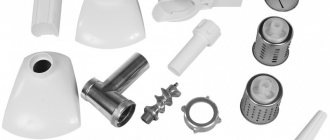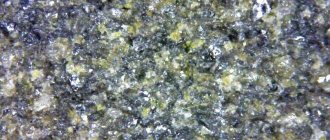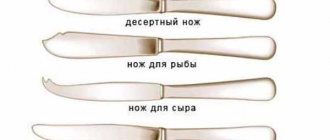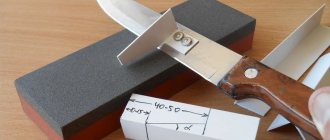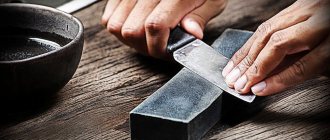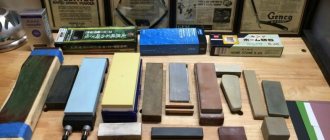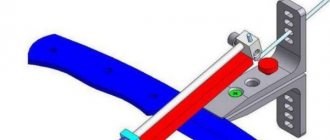What is knife polish
Musat is a tool that looks like a metal or ceramic rod with a plastic or wooden handle.
To prevent hand cuts, there is a guard located between the handle and the working part of the tool. The sharpening base of different products differs in the softness of the material. The surface of the rod can be smooth or rough. The advantage of musats is their magnetized surface. Thanks to this feature, metal particles do not fly apart, but remain on the tool shaft.
Musat is used for straightening blades with a hardness above 50 HRC, otherwise the tool removes too much metal. Ineffective at hardness levels greater than 60 HRC.
Features of Musat
So, you’ve figured out what musat is and what it looks like. It is necessary to find out what the features of this device are, including the rules for working with musat in practice. As has already become clear, musat and a sharpening stone are fundamentally different from each other. Ordinary musats sharpen the blade, provided that the blade has been previously sharpened and has a shaped edge. During straightening, the musat removes only metal crumbs from it and smoothes out all kinds of kinks and nicks. Only occasionally is the musat able to slightly sharpen the blade, barely cutting off a layer of metal from the tool.
Meanwhile, the whetstone is a complete device specifically for sharpening. Such a stone removes metal from the very edge of the knife, forming a sharp angle. Sharpening stones are rarely used and are not used with kitchen knives. The reason is that sharpening creates metal shavings on the surface of the knife, sawdust can later get into the food when cutting with the knife.
In stores there are separately both glass and steel musats, as well as ceramic and diamond options. But many manufacturers combine both of these products into one, thus making a combined musat. In it, one of the sides is used to sharpen the blade (as a rule, it is coarser), and the other is used to straighten the blade. They also produce musats with all sorts of textures. In this case, both sides are intended exclusively for editing the tool. Both sides are made from the same material; they do not contain ceramics or diamond chips. On the one hand, the musat can be mirror-like, on the other, it can have a rough surface.
Types of devices by shape
Products may have different cross-sectional shapes. Possible options:
- Round. The tool is lightweight.
- Oval. More convenient to use, have greater contact with the surface of the knife.
- Faceted. There are flat, tetrahedral and D-shaped. In the first case, linear contact with the blade is ensured; in the second and third cases, special sharpening is carried out due to the combination of the functions of a flat and volumetric tool.
There is also a tabletop V-shaped musat. It consists of 2 rods that are installed on the base at the desired angle.
Musat with a round cross-section.
Musat with an oval cross-section.
Flat Musat.
D-shaped section of musat.
Tabletop V-shaped grinder.
What are musats used for?
It is logical to assume that the thickness of the steel at the cutting edge is very small. Thanks to this, the knife has cutting ability. But it also makes it vulnerable to situations it wasn't designed for. This refers to situations such as: hitting a hard bone with an edge when cutting meat, the presence of salt crystals on the cutting board, or a strong blow to the cutting board itself. All these events will lead to jamming of the cutting edge. To the naked eye it will appear that the knife is still sharp, but if we look at the edge under a microscope, we will see that some parts of the blade will be bent to the side or completely inverted, which greatly reduces the cutting ability of the knife.
electron microscope photograph of a 600x stainless steel blade sharpened with 220 grit
The musat is needed to ensure that those sections of the blade that have been jammed are aligned and straightened.
Varieties of musats for sharpening knives, step-by-step production
There is no such person who has never resorted to the help of cutting tools. Their blades become dull over time and become less effective. You can restore the sharpness of the blade in different ways. For example, using musat to sharpen knives is a fairly simple but effective device. Manufacturers offer models of different shapes and quality; everyone can choose the appropriate option - from the layman to the professional.
- What is
- Kinds
- By material
- By purpose
- By shape
- How to use
- How to make it yourself
- Video
Types of musats by material
Musats are made of metal or ceramics and may have an abrasive coating. Each product has different performance characteristics.
Metal
The rod is made of hard steel (chrome vanadium), characterized by resistance to corrosion. It can be smooth or have notches of various sizes.
Aluminum rods are less common. Such tools are designed to correct bends and have low abrasive properties.
Steel musat
For its manufacture, hard chrome vanadium steel is used.
Its surface is smooth. It is intended for straightening and polishing the cutter. It is not used for sharpening knives. There are notches on it.
Mixed ones consist of two surfaces - one smooth, the other rough.
Musats also differ in shape. They are divided into 2 categories. The first includes round and oval. The second one is faceted, flat and tetrahedral. Round ones are light in weight, while oval ones make the editing process more convenient.
Flat ones provide close linear contact, while tetrahedral ones have the advantages of all musats.
There is another division of musats - according to application:
- Household. They are mostly from 18 to 23 cm long. These are inexpensive musats.
- Universal - from 26 to 29 cm. They come complete with high-quality cutters. They are more expensive.
- Professional. They are 26-36 cm in size. Each industry has its own musat. So, for cutting meat, a thinner musat of 32-36 cm is used, and cooks use short musat, from 26 cm.
How to choose musat for knives will depend on your profession and the purpose of the cutter.
Diamond grinders for sharpening knives
Diamond polish is considered the best polish for knives.
The housewife can easily straighten a dull cleaver with a few simple movements of the knife on the musat. Diamond grinders are used for straightening and polishing knives. Not used for sharpening.
Diamond grinding stone is made of hard chrome-plated steel, coated with diamond sand on top. It is oval in shape, which avoids the appearance of nicks on it. Choosing musat for a kitchen knife is simple. This is a diamond musat because it will bring the dullest cleaver back to life and remain sharp for a long time.
To preserve diamond pulp for a long time, you need to wash it by hand and under no circumstances place it next to hard objects.
Ceramic grinding tools for sharpening knives
This group of musats is covered with ceramic coating.
Ceramic knife grinder has two roughness surfaces. One with notches. It helps to remove a layer of metal, like sharpening knives. The second one is smooth. It is for straightening and polishing cutters. It is more delicate than steel.
If you unexpectedly hit the ceramic musket or use it incorrectly, chips will not form on the cleaver. If they are formed, then they are insignificant, in small quantities.
To sharpen mild steel cutters, it is better to use a ceramic grinder. It is intended mainly for delicate knife editing.
Ceramic musat rules cleavers with wide blades and old, worn ones.
Mixed
The tool has 2 types of surface: smooth on one side and abrasive on the other. This combination allows you to create a high level of blade sharpness.
The mixed musat has a ribbed surface on one side for straightening the knife.
How to properly care
Musat should be stored hanging or on a special stand.
The instrument must be washed manually using a soft sponge. Musates with abrasive coating should not be stored with hard objects.
join the discussion
Share with your friends
A good kitchen knife is the key to beautifully cut dishes and a satisfied cook. The correct device is considered to be the one that performs its main function - cutting and not breaking food. But after prolonged use, even professional models lose their sharpness. Then the need for musat arises.
Varieties of musats by shape
The material of the rod is not the only thing that can differentiate musats. The rods can also have different shapes, described below:
Round rod
One of the most common on the market. Its main advantage is that it is usually lighter in weight compared to other types of rods.
Oval rod
Its contact surface is larger than a round rod, making it easier for inexperienced chefs to sharpen knives.
Flat rod
With an even larger contact surface than an oval rod, this type of rod makes straightening (or sharpening) your knives quick and easy. The disadvantage is that it is heavier than the others.
Square rod
This original type of rod offers 2 different sharpening levels. Indeed, two faces of the rod have a certain grain size, while the other two faces have a different grain size. This type should be used carefully because the corners (edges) of the shaft can damage the blade if you are not careful.
V-shape sharpener
The market is also represented by several companies, such as Lansky, Idahone. It consists of two or four rods installed on the base at the desired angle. It is very easy to use because it does not require installation and maintenance of the correct sharpening angle.
Varieties
Musats are distinguished by material. Ceramic ones are characterized by a special coating. On one side there are notches that allow you to process the metal layer of the knife. On the other hand, the surface is smooth - for polishing and straightening. Such a tool is necessary for sharpening old devices or products with a not very durable surface.
a diamond tool, you can sharpen a knife, polish the surface and edit in a few movements. For its production, the industry uses special chrome steel, which is characterized by high strength. The outer part is coated with diamond particles. The knife remains sharp for a long time after processing.
Once you have finished working with diamond wax, be sure to rinse it by hand to keep the tool in good condition for a long time.
The metal device is made of chrome vanadium steel. It has high hardness and different working surfaces.
Musats are also distinguished by their form , which must be chosen based on the main goal. If you need the lightest possible tool, then it is rational to opt for a round model . To create maximum tight contact with the surface - on an oval .
It is believed that the best sharpening results can be obtained when using a flat tool. Tetrahedral instruments are a symbiosis of several types and are necessary in special cases.
Types by function
Musat is intended for straightening a knife, but some types of tools can be used for sharpening.
For grinding
Steel grinders, which have a smooth surface, are distinguished by gentle polishing and remove a small amount of metal. For straightening, notched rods are also used, which have a velvety texture due to the large number and low height of the ribs. A rough cut is used if the edge has not only been bent, but also polished when grinding hard steels.
The coarser the rod, the more intense the material removal from the blade. To polish blades made of low-hardness steel, it is recommended to use a tool with a smooth ceramic surface. Sanding is carried out with light pressure.
For initial sharpening
Abrasive musats are suitable for sharpening.
Ceramic grinding stone for initial sharpening of knives.
These include the following types:
- With rough ceramic coating. Not for use on hard blades.
- Diamond.
The abrasive surface acts as a grindstone. The softer the material of the cutting part of the knife, the finer the spraying should be. The amount of metal to be ground depends on the grain size and the pressure applied.
Must is not used for deep sharpening, because... may damage the blade. For this purpose, it is recommended to use special machines or sharpening stones.
Recommendations for selection
To select a quality tool, you must follow the following rules.
- Choose a model in which you can see your own reflection. Professional chefs are guided by this indicator.
- The magnet on the tip of the musat increases the level of comfort of its use. After all, this way you can effortlessly remove dust from the knife.
- To protect your fingers from possible damage, choose models with a guard between the handle and the rod.
- As for materials, pay special attention to ceramics, since such a tool is characterized by durability and excellent sharpening properties without harming the steel of the knife.
Ceramic musat is fragile, so you need to be very careful with it, since every blow causes chips and cracks.
- Follow the rules for storing tools. If, for example, a diamond tool is stored together with knives and other hard objects, it will quickly become dull.
Before choosing a musat, carefully check the quality of the product and its rating in relation to other models. A good diamond tool will not lose its coating. Ceramic models have no visible mechanical damage. The density of the steel model is uniform, without roughness. And only if these indicators are observed, it is possible to buy the best musat offered by the market.
How to choose a good knife polish
When choosing a musat, you need to pay attention to the presence of a guard, which makes the use of the tool safe.
It is important to evaluate quality performance:
- Regardless of the type of material from which the musat is made, the surface of the rod must be uniform. The presence of small defects and roughness on smooth steel is unacceptable. When processing a knife, they can damage the blade. The surface structure must have uniform density.
- If the rod has notches, they should be evenly and parallel, without protrusions or notches.
- The diamond coating should not crumble or crumble.
- The ceramic coating should not be chipped or damaged.
- The musat should not be smaller than the blade of a knife (the best option is 5 cm longer). Universal products range in size from 26 to 29 cm (often included in knife sets). For home use, a length of 18 to 20 cm is often sufficient. Longer products (up to 36 cm) are intended for professional use.
One of the requirements that professional chefs have for tools with a smooth steel surface is that they have a polish that allows you to see your own reflection.
Musat length
The length of the musat (not including the handle) should be at least 5 cm longer than the length of the longest knife on which you are going to edit it. (Bread knives and other serrated knives do not count; that's a topic for another article). Additional centimeters are needed to make it convenient to move the entire edge of the knife down the sharpening in one movement.
Musat handle
When choosing a musat, you should pay attention to its handle. It is very important to hold the grinder firmly so that it does not slip while working. This can damage both the knife and you!
Look for an ergonomic handle that fits comfortably in your hand, is made of non-slip material, and has a guard to protect your hand while honing.
Musat grain size
Musats have three main degrees of grain size; accordingly, they are:
- Coarse-grained (coarse);
- medium, small (fine);
- very small (extra fine).
In numbers, this is depicted as 400-500 - coarse grain, 600-700 - medium grain, everything over 1000 - 1200, 1400, 1500 - these are indicators of fine grain. Average indicators are the most preferred and universal.
Coarse grain is too coarse, which is good for roughing and rough grinding. Sharpening them, especially in field conditions, when we don’t have time and special conditions, can lead to deformation of the cutting edge and the final dulling of the blade.
Fine grain is good only for finishing, grinding an already sharpened blade with a formed cutting edge. In all other cases, musat with such characteristics will only stroke the blade and slide along it. Such devices are not intended for thorough sharpening, but for straightening and sharpening the blade, so you should not abuse them.
In what cases is steel musat used, and in what cases is ceramic or diamond musat used?
Ceramic and diamond coated grinders can be used both to correct the cutting edge and to temporarily restore the sharpness of a knife when there is no time for full sharpening, and metal grinders are most often used only for straightening.
Now you know all the criteria that need to be taken into account when choosing one of the musats! Cooking with dull knives is no longer an excuse!
Diamond musat - features
It is well known that diamond is a very hard material, so blades can be sharpened very quickly with diamond grinding stone. Sharpening with “diamond” is very fast and easy; in the process, a rather aggressive cutting edge is formed, which is essentially a microsaw.
A significant drawback of this feature is the rapid chipping and dulling of the blade: the small teeth of this microsaw simply break off. While ceramic forms a much smoother edge base, it does not chip as quickly.
There is an opinion that diamond and other coated varieties are not real musats, but simply sharpening devices in the form of musat rods, bars of this shape, equipped with handles.
Other features – sizes and markings. With dimensions, everything is quite simple: the smaller the grind, the less effective it is: the surface area of contact with the blade is small, the sharpening accuracy also decreases. Therefore, small musats are by no means a panacea, and are only good in the absence of normal equipment.
As for labeling, we must not forget that manufacturers often do not indicate the grain size characteristics on small musats. Often, on such models it is average, and it’s good if that’s the case. You can only check them “by eye” and “by touch”, testing them on a knife that you don’t mind.
Diamond grinds are well suited for rough tools (axes, sapper blades, etc.) or hard steel blades - with a Rockwell rating of more than 60 units. There are also special varieties of such grinders for sharpening ceramic blades.
Features of ceramic musats
Ceramic musats are used to repair minor damage to the blade. Or in the case when the blade is still quite sharp - and the coarse-grained option is not suitable. Then we need something as smooth and even as possible.
Ceramics, in general, is a very hard material; it is ideal for sharpening knives made of mild steel. She simply grinds off the less hard options. Blades whose hardness is in the range of 58-63 Rockwell units are just the most suitable pair for ceramic musats. Ceramic musat allows you to maintain blades in almost perfect condition, significantly increasing the maintenance of the knife in working condition
The main disadvantage of ceramic musats is their fragility and salinity. On the other hand, diamond ones “go bald” quite quickly when actively working with them.
Both types of musat deserve the right to be in your kitchen or in your camping equipment. Each of them just has its own specifics. Study their features, compare the price with the characteristics of the musat you have chosen, and this will help you find the most optimal option.
Musat is a special sharpening device. The sharpening agent must be harder than the steel of the knife. Therefore, in the manufacture of musats, various solid materials are used. There are two main types, the most common: diamond and ceramic. In essence, all musats are finishing tools. If after straightening the knife there are no dark traces on the musat (particles of metal erased during the straightening process), then it is musat, and it is the musat that straightens the cutting edge. Otherwise, these are the same sharpening stones in the form of musat.
Diamond grinders are a type of sharpening device: solid rods, the surface of which is covered with microparticles of synthetic diamonds. Diamond musats differ in grain size, which during production is regulated by the different content of diamond chip fractions. A classic example of such a product is the 0825 D diamond sharpener from Grand Way. Equipped with a non-slip plastic handle, this musat is ideally suited for the kitchen: it does not slip even in wet hands, and is not afraid of moisture on its own.
Which one do the professionals choose?
Professional grinders are distinguished by their size - the length of the entire tool does not exceed 260 mm. Chefs claim that the surface of the “rod” should be polished as much as possible in order to see one’s own reflection in it. This means that you should pay attention to metal and steel sharpening tools.
If the choice is made to use musat in a regular kitchen, then it will be especially convenient with a thin rod, because it will be easy for them to sharpen both narrow and wide knives of different shapes.
Recommendations for selection
According to professionals, the best ones are those with a polished working surface, on which you can see your own reflection:
- The magnetized tip of the product makes work easier. It helps to quickly remove metal dust deposited on the surface of the knife.
- To avoid injury to your fingers during operation, there must be a special guard between the rod and the handle.
- Ceramic musats are considered the most durable. They sharpen knives perfectly, removing a minimal layer of metal. The disadvantage of these products is their high fragility. After falling or hitting the surface, a crack or chip may appear.
When choosing musat, you need to take into account the grade of steel from which the blade is made, as well as its hardness. Now you know what musat is and why it is needed in everyday life.
There must be a guard for safety
Choose a magnetized tip
The best is ceramics
How to use musat
You can edit using musat in different ways, changing the location of the knife and tool. There are 2 classic techniques: suspended or supported on a surface. In both cases, the edge is processed on both sides of the blade alternately. The location of the cutting edge down or up also changes.
It is important to sharpen the knife correctly with musat: the blade should be located in relation to the rod at an angle of up to 20-30 degrees. Sliding at one level is less efficient than moving the working part of the knife along the entire length of the rod.
How to sharpen a knife with musat: a “do-it-yourself” technique
This method is also called “in the air”, “in weight”, “in midair”. This is how professionals and experienced chefs edit the blade. In essence, the procedure resembles the actions of a butcher with two knives, which we talked about in the introduction. Only instead of one of the knives there is musat. Hand actions are quick but precise and require skill. Here's how to properly sharpen a knife using musat using this technique:
- A right-handed person takes a knife in his right hand, and musat in his left hand (left-handed - vice versa).
- Place the heel of the knife on the top of the blade at the desired angle (the initial sharpening angle of the blade specified by the manufacturer). The thin edge of the blade “looks” at you.
- Maintaining the set angle, move the blade downwards along the musat with a slight sliding movement, while simultaneously moving the blade towards the tip - a movement towards yourself.
- The movement ends at the guard after the entire area of the cutting edge passes along the rod.
- Now place the heel of the knife at the bottom of the musat near the guard and make the opposite movement - slide the knife up. Do not forget about the need to maintain the sharpening angle and move the blade itself towards you.
- Repeat the sharpening cycle 4-5 times.
Sharpening time is only about 1 minute if the knife is not very dull and sharpening is carried out frequently. If the knife remains dull, the procedure time and number of cycles are increased until the expected sharpness is achieved. You can check whether the knife is well sharpened by running the blade along a sheet of paper. Normally, it is easily cut by weight. All that remains is to rinse the knife with water and wipe dry. Wipe the rod with a damp towel to effectively remove metal particles.
How to use musat: “on your own” technique
This method is also called “calm”, “Calmly”, “safe”. It's great for beginners. However, many professionals also choose this technique for its simplicity. In this case, the tip of the musat rests on a board or tabletop lined with a towel or cloth. Here's how to properly sharpen with musat using this technology:
- Hold the knife with your right hand, and the musat with your left (for left-handed people, the opposite is true).
- Move the rod slightly to the left, the angle between the rod and the board is about 20-25 degrees.
- Place the knife at a right angle to the table with the cutting edge down, setting the desired sharpening angle.
- From the base of the musat, use the heel of the knife to move the entire edge of the blade towards the tip of the rod, maintaining the desired sharpening angle of the knife. It is necessary to finish before the blade touches the table, otherwise the edge will not be sharpened.
- Now tilt the musat to the right and make a edit by running the other side of the blade along the shaft.
The number of sharpening cycles depends on the material used to make the grinder, the pressure applied and the degree of dullness of the knife. So, with diamond grinding stone you can sharpen a not too dull knife in just 1 cycle, with ceramic grinding stone - in 3-6 cycles. And if the knife is dull, it is sharpened as much as necessary to achieve the desired sharpness. If straightening with musat was not carried out for a long time or never at all, then the cutting edge could become heavily curled or polished. In this situation, when editing the musat, you need to move the knife with strong pressure. When multiple attempts to “reanimate” the cutting edge in this way have not brought results, musat is unlikely to help. You will have to turn to the “heavy artillery” - the sharpening tool. You should not even try to straighten the cutting edge if it has nicks, visible nicks, or is severely damaged. This tool can only be saved by deep sharpening on a sharpening machine and removing the metal layer.
Sharpening by weight
The method involves placing the tool in suspended position. The algorithm of actions is as follows:
- One hand holds the musat in a horizontal position.
- In the other hand there is a knife. The blade (from the handle) is applied with the tip up to the end of the rod.
- When the hand is moved down, the blade lowers and slides along the shaft towards its base (from the handle to the tip). Only the hand should move, because... When moving the knife, the likelihood of injury from the shifting tip increases.
- The hand holding the musat does not move.
It is safer to place the musat slightly downward (away from you). In this case, the blade is applied from the handle to the base of the rod at the guard. The knife is lowered so that its cutting part slides along the entire length of the musat to the tip. The risk of cutting yourself is minimal, because the movement is directed away from the hand with the tool.
The “In midair” position assumes that work with musat is carried out in weight without additional support.
Sharpening with support
It is assumed that there is a support on which the musat is held vertically with the handle up.
Editing is carried out according to the following algorithm:
- The working part of the knife is applied with the base at the handle under the musat guard. The recommended angle is 10-15°.
- The hand with the knife is pulled back, while the blade slides down the shaft, moving towards the tip. The movements are reminiscent of cutting bark from a branch.
This is a safe method; causing injury with a blade is almost impossible. For support, it is important to choose surfaces that do not slip.
Dressing a knife with musat
To straighten knives you will need some grinding cloth and a non-slip surface.
Musat can be useful not only for sharpening blades, but also for straightening them. How to do it right? There are certain rules for how to sharpen a knife with musat:
- as with sharpening, place the grinder on a non-slip surface (a towel or cutting board is suitable as a “lining”);
- tilt the musat to the left 20–25 degrees;
- place the tip of the knife on the right at the very beginning of the rod and move it from the base to the tip, directing the movement downward;
- do the same with the other side of the slicing device, tilting the musat to the right.
These actions are performed until the knife blade acquires the desired sharpness.
How often should you use the musat?
Editing is a preventative procedure that must be done regularly.
How to properly sharpen knives with musat
Before we talk about the rules for using this tool, it should be noted that musats are intended only for knives with a smooth blade. They cannot be used if the cutting surface is wavy or jagged.
When sharpening a knife with musat, the blade does not become thinner, but only straightens. This is its main difference from other sharpening devices. This feature allows you to use the grinder before each cooking, since even frequent sharpening will not affect the durability of the blade.
How to sharpen knives with musat? Remember that a good effect from using musat is achieved only if you use it correctly. Follow this sequence of actions:
- Place the end of the tool on a non-slip surface. A towel laid out on the kitchen table is best suited for this.
- During sharpening, hold the knife blade at an angle of 200.
- Run the cutting surface over the musat several times. First from bottom to top, and then forward and backward.
- Repeat the same steps on the other side of the blade.
It is important not to press too hard on the blade while sharpening, otherwise it may gouge.
How many times should you run a knife along the shaft of the musat to ensure that the blade becomes optimally sharp? If you are using a diamond tool, once on each side is enough. And when using a ceramic rod, you need to repeat these movements 3-6 times.
Types of musats
Ceramic grinding stone is excellent for sharpening large and wide blades.
It is very important to choose the right tool to ensure the best effect from its use. To do this, first of all you need to pay attention to its purpose. There are such musats:
- for grinding a blade that has already been sharpened;
- for initial sharpening of knife edges.
Related article: Decorative pots with felt flowers
It is also worth deciding on the material of the musat, which is most often “diamond” or ceramic.
The first type of nuts is made of hard chrome-plated steel, which is then coated with “diamond” sand. Sharpening with the help of such devices occurs very quickly. For excellent results, you just need to run the rod once along each side of the blade.
“Diamond” musats have many advantages.
In addition, a distinctive feature of “diamond” tools is their oval shape. It eliminates the possibility of indentations forming on the tip. Even if you accidentally press the nut too hard in one place, there will be no unwanted nicks or grooves left there. At the same time, the sharpening rod made of “diamond” steel is quite rough to “bring back to life” even the most dull blade. After treating the edge with “diamond” musat, it remains sharp and smooth for a long time.
With all its advantages, this kitchen appliance is also very easy to store. It does not require special care. And in order for the musat to last longer, it is enough to follow only two rules: do not put it in the same drawer with other hard objects and wash it by hand, and not in the dishwasher.
A ceramic rod is also used for sharpening and final grinding of cutting surfaces. Such models come in round or oval shape. Musat made from this material perfectly sharpens large and wide blades. It is even suitable for the “cleaver” used to cut meat. With its help, you can make a heavily worn knife sharper, and it does an excellent job of polishing the blade.
How can you tell if a knife is sharp enough?
After sharpening, you must check whether the blade is sharpened well. To do this, you can use one of these methods:
- Select a strand of hair at the back of your head and press the knife against it at a right angle. Swipe through hair from top to bottom without making sudden movements. If the blade is still dull, it will slip off easily, whereas a sharpened point will stick.
- Take a newspaper or sheet of paper and hold it suspended. In this position, try cutting the sheets: if you succeed, the sharpened knife is already quite sharp.
For many cooks, musat has become an indispensable item in the kitchen. This is due to the fact that it is easy to use, it does not damage knife blades and lasts a very long time if used correctly.
Blade Sharpness Determination
You can check the sharpness of the cutting edge with your finger, but do not run it along the knife. The blade should be moved across the finger. This method requires training and experience.
To check the quality of blade editing, you can use a standard sheet of A4 paper.
There are other reliable and safe methods:
- Paper. Holding the sheet suspended, you need to cut a thin strip from it. A properly sharpened knife carefully cuts through paper without creasing it. The sharper the edge, the thinner the strip you can cut.
- Tomatoes. The sharpened cutting edge easily cuts the tomato under the influence of the weight of the blade and does not crush the skin.
- Hair. This method requires caution. It is necessary to bring the blade to the hair on your arm (against your height). If the edge is not straightened, the hair will bend. A sharp edge will cut it off.
How to make musat from an electrode
If you wish, you can make this sharpening tool from an electrode with your own hands; to do this, you will need to follow the steps in the following order:
- Prepare a surfacing electrode, the most suitable ones will be from . Cut it to the required length (within 180-200 mm).
- Remove the top layer from the surface of the rod with a whetstone. It is worth using such a tool with a fine abrasive surface.
- A handle must be attached to one end of the electrode. It can be made of wood or plastic; in the latter case, it is recommended to use a ready-made screwdriver or any other suitable tool.
Homemade musat from an electrode is ineffective; it is suitable only for straightening kitchen knives, and this process will need to be carried out almost every day.
Musats are used by both professional chefs and housewives. They are convenient for sharpening/sharpening any knives, you just need to make the right choice of tool. They have a long service life provided proper care and storage.
Caring for musats
Musats are unpretentious in care and storage, but you should still follow certain recommendations:
- Store separately from cutlery and tools so that metal objects do not touch the rod.
- Wash by hand, machine washing is prohibited.
- Wipe with a dry, lint-free cloth.
- Use for its intended purpose - for knives with a certain hardness and type of steel (for example, metal grinding is not suitable for ceramic knives - upon contact, the rod will be scratched and erased, but the blade will remain dull).
Sources
- https://VashNozh.ru/zatochka/musat-dlya-zatochki-nozhej
- https://fonarik.com/chto-takoe-musat-i-chem-on-otlichaetsya-ot-tochilnogo-kamnya/
- https://forest-home.ru/blog/kak-tochit-nozh-s-pomoshchyu-musata/
- https://kakchistim.ru/uhod-za-veshchami/chto-takoe-musat-dlya-nozhej.html
- https://tochilkazhuk.ru/kak-pravilno-vybrat-musat-dlya-zatochki-nozhej/
- https://uzinform.com.ua/news/2018/05/24/155156.html
- https://mse02.ru/kak-vybrat-musat-dlya-kukhni/
- https://posuda-gid.ru/nozhi/obsluzhivanie/110-musat-dlya-zatochki
- https://samura-online.ru/articles/kak-tochit-nozhi-musatom.html
- https://DekorMyHome.ru/rukodelie/kak-ispolzovat-mysat-dlia-zatochki-nojei.html
- https://www.ru-chef.ru/blogs/articles/%D0%9F%D1%80%D0%BE%D1%81%D1%82%D0%BE-%D0%BE-%D0%BC %D1%83%D1%81%D0%B0%D1%82%D0%B0%D1%85
